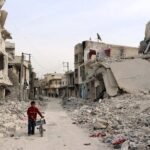What is your familial background and personal story?
I come from a traditional Kurdish family. My mother has no education, but she worked as a local midwife. My father was a radiographer, and is a Muslim Imam. My eldest brother studied fine art in the Institute of Fine Art in Mosul. He is a highly respected and influential member of the family. He inspired myself and many of my other siblings to get involved in the arts. At the time that I was growing up, the unstable situation in Northern Iraq (Kurdistan) was in full swing, living under an Iraqi dictator, with no respect for basic rights, and we were considered second class citizens. We were tortured, and lived under fear and terror. My childhood in this context has had a strong effect on who I am today.
You were born in South Kurdistan, or Northern Iraq, in 1980. That year, the war began between Iran and Iraq. You saw humans act with savage brutality. How did this influence your perspective on life and people?
My perspective is a constant call for peace and rights. Art can hold a beautiful message, such as harmony, beauty and humanity. Art makes life better and beautiful, it facilitates living in peace, a colourful life. I am optimistic. My perspective is one of abject wonder regarding how people can destroy each other, themselves and nature. I believe we can all live in peace.
After The Kurdish Uprising, your family migrated. You were a student at the Erbil College of Fine Art from 1998-2002. Why did you choose this place of study? How did the training and credential help with personal and professional development?
As I mentioned, my oldest brother was a powerful influence on me. When I was young, I looked at him, the way he painted and made drawings. I starting drawing, and it has been a major part of my life since then. This passion for art substantiated itself in the academic study of art and the art movement. I wanted to become technically, practically and theoretically skilled. The choice of Erbil College of Fine Art was an accident at the time, my family ended up in Erbil and it was the only place to study fine art in the city. It was a good accident though, I learned an awful lot there, and met many close friends and interesting influences. My time at Erbil brought me through a personal and professional development in the sense that I moved from a young man passionate about art, to a man confident in his ability to run an art gallery, to write for and edit a fine art magazine, and to be successful in this field.
You fight for human rights through art. How, and why?
I grew up in a warzone, in a violent environment. Since my childhood, and until I left Kurdistan, I lived in fear, surrounded by fighting, and never in a stable situation. There were constant images of violence. Tools of war became a part of normal life. I always asked myself ‘why?’. ‘Why are people killing each other, torturing each other, hating each other?’ Whether for religious purposes, political purposes, etc., to me it is unacceptable to annihilate an individual or group of people no matter the reason. I particularly focussed on the Muslim religion, and I did not see any space for a human being to live as a free human in a Muslim world, free to think, to behave freely, free to live the way they want to live. One of my early exhibitions was called “fear”, and this was based on the fact that people are tortured for the sake of honour, religion, or different purposes – in particular, women.
Would you consider yourself socially progressive? If so, why? If not, why not?
Yes, I consider myself socially progressive. The nature of humanity is all about change, experimentation, improvement, growth and development. Therefore, day by day, humans are widely progressive in terms of technology, in terms of social life, scientifically, economically, etc.
Who is your favourite human rights activist, dead or alive?
Mahatma Gandhi and Nelson Mandela. To me Gandhi is the “god” of his philosophy of non-violence in activism. Mandela, as one of the pillars of the idea that humans can live together, peacefully.
You went to Ireland to continue artistic studies in 2007 at The Galway Mayo Institute of Technology from 2009 to 2014. How did further refine professional skills to create art that fights for human rights?
My studies in Galway had a huge impact on both my skill and art education. I experimented with different media in order to express my ideas, such as in the medium of print-making and video art. Through this institution I expressed all my feelings in the context of human rights, and how the art has an effect on the audience, and the strength and power of art in delivering a message through a particular technique. Ultimately this was a great experience, one that enhanced my skills dramatically.
You approached the Minister of Culture of the Kurdish government to create a new gallery in Erbil City called the “Palace Art Gallery.” It was built. What was that experience like running the operation for its first year?
At the time, I was running an art organisation, and working as a civil servant in the Kurdish Department of cinema, and working as an editor of the Modern Art Magazine, supported by the Ministry of culture. I approached the Minister of Culture regarding the Art Gallery. The Minister was instantly pleased with the proposal and agreed to build the Palace Gallery. That was first ever experience to work in a gallery as a curator and director. Our first exhibition lasted for four months after opening, and twenty artists from the area and nearby regions were involved. It was a great platform to combine the works of these talented individuals. Also, to encourage and provide the opportunity for more artists to become involved. The mission of the Palace Gallery was different to that of other galleries at the time, in the sense of the openness to variation and celebration of different vibes, to bring dynamism and movement in the field of fine art in Erbil city. Unfortunately, I was young at the time, and perhaps naïve. Older, more established individuals (with more pull with the Minister for culture than I had) that felt that I was too inexperienced, and an outsider, caused the funding for the gallery to be withdrawn, without which the new gallery could not survive.
How did this provide a platform for your work and fight for human rights?
The majority of the works displayed at the gallery were reflections of the reality of Kurdistan at the time and rejections of the war and violence. All of the messages were that of humanity, continuity of the human race, of a time when humans can live in peace together, of human rights and human dignity. Each artist had their own technique and their own perspective, using different materials. This combination between the artists made the exhibition more powerful, and more reaching to the audience to deliver these messages in favour of the protection of human rights.
Thank you for your time, Ali.








Article Discussion